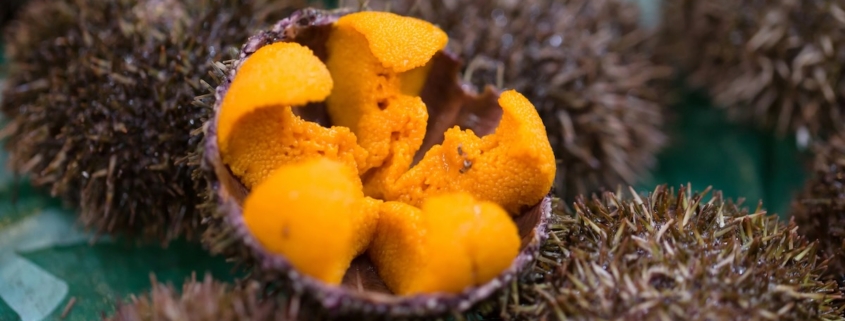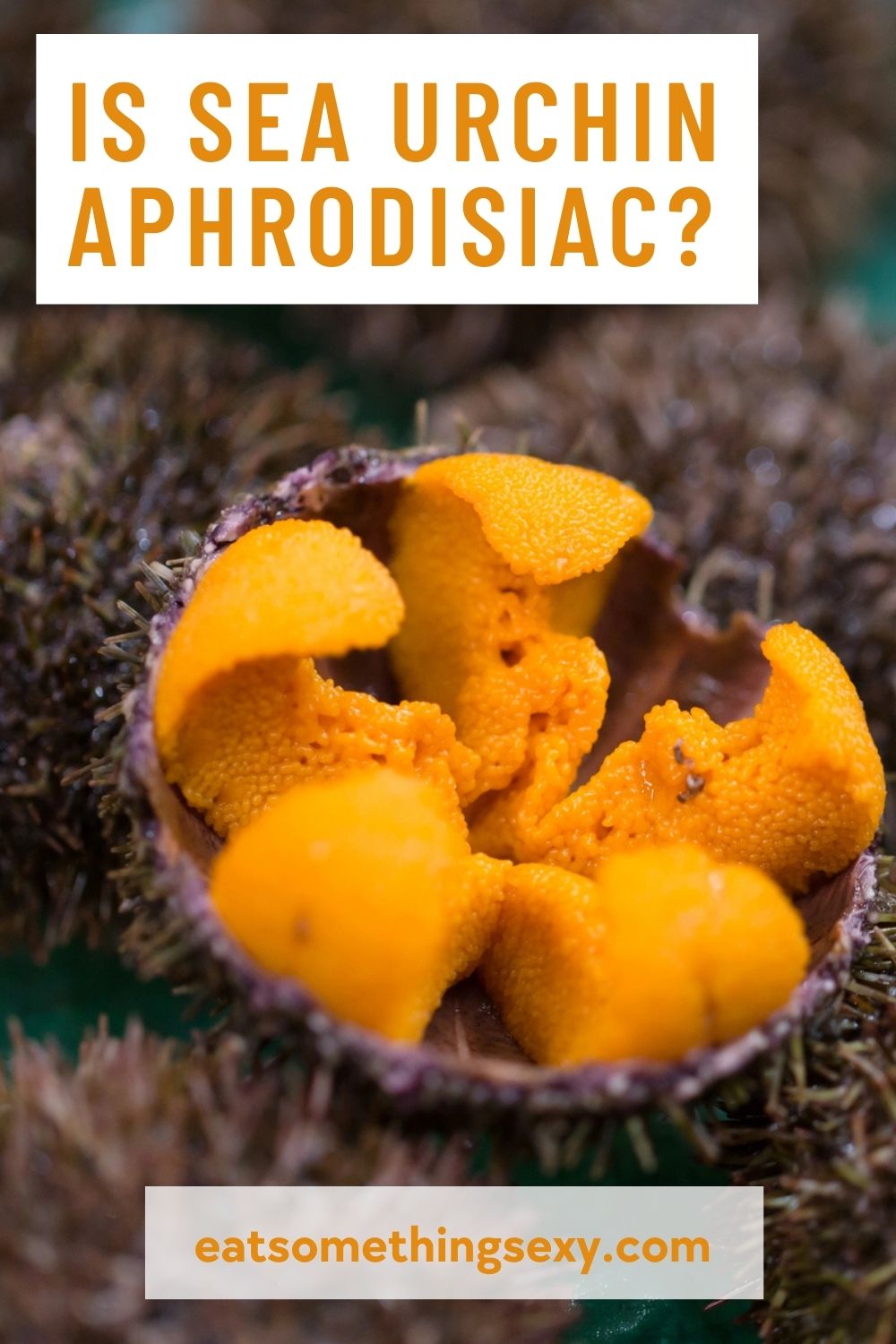
A sensual ingredient appreciated in Japan for its unique flavor and aphrodisiac qualities, sea urchin, or uni, as the Japanese call it, rose to popularity in North America in the late twentieth century. This unusual and alluring ingredient is also popular in France, where sea urchins are called oursins and in Italy, where they are known as ricci di mare.
If you’re wondering, “Is sea urchin aphrodisiac because the part you eat is the roe?” you’re in for a surprise. Contrary to popular belief, the portion of the sea urchin sold and served as one of the ocean’s most tasty treasures is not the roe.
Roe refers to eggs, and that’s not what you’re eating when you enjoy this gift of the sea. It is the gonads of this sea creature that are scooped out of the urchin’s spiny shell in five custard-like, golden sections.
Why is sea urchin an aphrodisiac?
Some say the distinctive perfume of the sea urchin, slightly briny and almost sweaty, gives it an aphrodisiac association. But most people believe that it’s the simple fact that the edible portion of these creatures, relatives of sea cucumbers, is a sexual organ that makes it a food of virility.
In addition, there’s a certain level of scarcity associated with sea urchins that makes them a luxury item and one associated with a certain level of desire. They cannot be collected in bulk. Sea urchins must be foraged. They are plucked one by one by skilled divers in cold ocean waters. This, to some, adds a sexy element to this seafood’s origin.
However, there is another, more powerful reason to enjoy sea urchin as a food of love. Uni is a nutritious food with the potential to support your sex life. And I believe its nutrition truly makes sea urchin successful as an aphrodisiac.
Sex benefits of sea urchin
Sea urchin is a surprisingly nutritious food. According to Global Seafoods a 3-4oz serving offers over 18 grams of protein. (Don’t forget that energy from protein is essential for sustaining a long night of seduction.) It’s also a source of magnesium, calcium, iron and vitamins A and B12. These nutrients will benefit your sexual health and overall wellness. But when we look at what else uni has to offer from a nutritional standpoint, things get interesting.
Sea urchin is one of the most prominent culinary sources of anandamide, a cannabinoid neurotransmitter. Does this mean that eating sea urchins will produce a similar effect to ingesting marijuana? Probably not, but it is possible that uni activates the dopamine system in the brain, humans’ built-in “reward circuit.”
Uni is also a source of omega-3 fatty acids. These essential fats are known not only to support cardiovascular health (and thereby support sexual health) but also to promote dopamine production. Without question, uni is a “happy” food. And foods that improve mood are thought to help us get in the mood. This may be why sea urchin has long been considered a top choice of ingredients to serve at an aphrodisiac meal.
Why is sea urchin so delicious?
Some say sea urchin is an acquired taste but for most of us, the very first bite of this unforgettable seafood opens the door to food sensations we’d never experienced before. The unusual, almost indescribable briny, savory, musky taste sensations that come with eating sea urchins have to do with umami.
Umami is the name for the fifth basic taste, along with sweet, salty, bitter and sour. It is often described as a general savoriness or, sometimes, it is simply described as what gives a food, “deliciousness.” According to the Umami Information Center, sea urchins are high in the umami compound glutamic acid. In other words, umami is high in natural “deliciousness.”
Is it bad to eat too much sea urchin?
Overconsumption of many seafoods comes with a risk of mercury poisoning. Luckily, sea urchin is considered a low mercury seafood according to the Natural Resources Defence Council.
That being said, high consumption of uni does come with a risk. Sea urchins are high in purines, chemical compounds found in foods that are known to cause gout. According to Very Well Fit, they are among the types of seafood that should be eaten in moderation to avoid the risk of gout.
Other sea urchin risks
The biggest risk associated with sea urchins has nothing to do with eating them but with stepping on one in shallow ocean waters. Their spins have venom and if a spin punctures the skin, it can result in poisoning.
Sea urchins are not among the shellfish that pose a risk for paralytic shellfish poisoning however there was at least one food poisoning outbreak believed to be caused by sea urchins sold from a single supplier.
Those with shellfish allergies should avoid eating uni as it has been known to cause an anaphylactic reaction.
How to serve this seafood
Uni is most often served raw. You will find it served as sushi or sashimi in many Japanese restaurants. In French bistros and Mediterranean seafood restaurants, you may find it served in the shell with a side of warm, crusty bread. (Dropping a section of its golden custard onto a lightly buttered slice of warm bread is my personal favorite way to enjoy sea urchin.)
You may find sea urchin served tossed in fresh pasta. And some chefs will treat it similarly to egg, using it in custard or whipped into a foam. But whatever way you choose to enjoy your uni, you can ensure it is fresh by checking both for a golden-orange color and a soft smooth texture. If your serving appears grainy or tastes bitter, do not eat it.
Discover more of the world’s greatest aphrodisiacs
This article was written in 2010 and most recently updated in April 2024.
Disclaimer: Please note that the information provided in this article is intended for informational purposes only and not to replace medical care. It is important to consult your physician before making dietary changes. More information
- Should You Use Moringa Powder for Sex? A Moringa Powder Review - April 11, 2024
- Carrot Juice Bloody Mary Mix: a sweet & sexy twist on a classic - March 21, 2024
- Authentic Japanese Shrimp Tempura Recipe - March 18, 2024
Did you know that eating the right foods can be the key to boost your sex life?
And we're going to help you start right now. Subscribe to Amy Reiley's private mailing list for weekly tips, recipes and honest advice. As a bonus, you'll get her exclusive list of Six Great Sex-Boosting Snack Foods for FREE!



Leave a Reply
Want to join the discussion?Feel free to contribute!